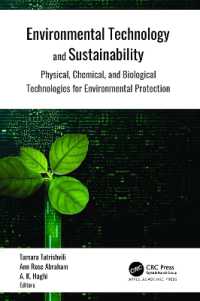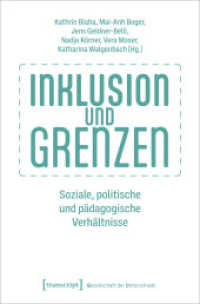- ホーム
- > 洋書
- > 英文書
- > Computer / General
Full Description
The two-volume set, LNAI 16221 and 16222, constitutes the proceedings of the 4th Mexican International Conference on Artificial Intelligence, MICAI 2025, held in Guanajuato, Mexico, November 3, 2025
The 65 full papers presented in these proceedings were carefully reviewed and selected from 119 submissions. The papers presented in these two volumes are organized in the following topical sections:
Part I - Machine Learning; Natural Language Processing and Neural Networks.
Part II - Applications; Pattern Recognition; Computer Vision & Image Processing and Bioinformatics & Medical Applications.
Contents
.- Applications.
.- AutoML for Text Classification via Efficient Dataset Representations and Hyper- Heuristics.
.- Rewarding Sentiment Consistency: Reinforcement Learning for Multilingual Summarization.
.- Stochastic Harmonic Fields for Safe Robot Navigation in Dynamic Environments.
.- Real-Time Passenger Feedback for Public Transport Optimization Using NLP and Multi-Agent RL.
.- MICAI: 25 Years of AI in Mexico.
.- A Dynamic Penalty Approach in MOEA/D for Constraint Handling in Multi-Objective Problems.
.- Urban Crop Coefficient Estimation for Outdoor Water Management Using Machine Learning.
.- Towards a Distributed-based Learning Robot from Scratch via Neuro-Evolutionary Computation.
.- Beyond SWE-Bench: A Compiler-Assisted Pipeline for Multi-Language Automated Program Repair.
.- Advanced parameter extraction for photovoltaic cells using the Black-winged Kite Algorithm.
.- Pattern Recognition.
.- Topological data analysis and convolutional neural networks for gravitational wave detection.
.- Data-Driven Power Time Series Imputation Using Cumulative Pattern Matching.
.- Day-Night Crime Transmission Networks for Temporal Urban Analysis.
.- Rethinking GAN-BERT for Sensitive Text Classification: The Impact of Training Dynamics and Domain Alignment in Low-Data Scenario.
.- Limits and Surprises of Cross-Lingual BERT under Data Scarcity: A Portuguese Case Study in Sensitive-Text Classification.
.- Computer Vision & Image Processing.
.- Recognition of Bee Organizational Behavior with Scene Graphs Generation.
.- Sign Language Recognition Using Video, Skeleton Data and Deep Learning.
.- Improving Tomosynthesis Sinograms via Particle Swarm Optimization.
.- Classification of Foliar Diseases in Tomato Crops Using Convolutional Neural Networks.
.- Sign Language Recognition and Translation with Large Multimodal Models. A Systematic Review.
.- Electrical Impedance Mammography Image Fusion Using the Gaussian Pyramid Method for Binary Classification.
.- Shadow Attenuation in UAV Multispectral Imaging for Enhanced Agave Segmentation.
.- From Keyframes to Narrative: A Multi-Stage AI Pipeline for Scene Understanding Using Object Detection and Large Language Models.
.- Volume Estimation of Travertine Blocks Using Keypoint Detection and Homography from Monocular Video.
.- Automated Ergonomic Risk Assessment in Offices using Computer Vision-Based Activity Recognition.
.- Real-Time Emotion Recognition in Intelligent Tutoring Systems.
.- Vision Transformers for Kidney Stone Image Classification: A Comparative Study with CNNs.
.- Artificial Vision-Guided Hexapod Robot for Autonomous Navigation and Object Localization.
.- Bioinformatics & Medical Applications.
.- Machine Learning-Driven Virtual Reality Intervention for Academic Social Anxiety: A Symbolic AI Prototype.
.- Automated Segmentation of Hepatic Tumor Cell Migration Using U-Net Models.
.- Efficacy of a multi-class AI ensemble model in preschoolers to predict nutritional status at school age in Mexico.
.- Classifying healthy and pathological voices: Electroglottographic signal representation using intuitionistic fuzzy recurrence plots.
.- Risk factors for hipertension and health policy.








